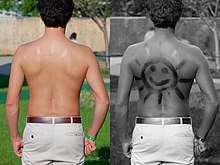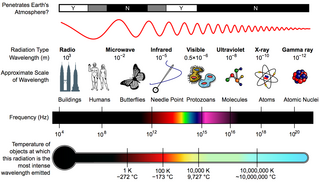
The electromagnetic spectrum is the spectrum of electromagnetic radiation, ranging over a domain of frequencies and their respective wavelengths and photon energies.

Infrared is electromagnetic radiation (EMR) in the spectral band between radio waves and visible light. It is invisible to the human eye. IR is generally understood to encompass wavelengths from around 1 millimeter to around 700 nanometers or 0.7 micrometers (430 terahertz).

Ultraviolet (UV) is a form of electromagnetic radiation with wavelength shorter than that of visible light, but longer than X-rays. UV radiation is present in sunlight, and constitutes about 10% of the total electromagnetic radiation output from the Sun. It is also produced by electric arcs; Cherenkov radiation; and specialized lights; such as mercury-vapor lamps, tanning lamps, and black lights.

The visible spectrum is the band of the electromagnetic spectrum that is visible to the human eye. Electromagnetic radiation in this range of wavelengths is called visible light. The optical spectrum is sometimes considered to be the same as the visible spectrum, but some authors define the term more broadly, to include the ultraviolet and infrared parts of the electromagnetic spectrum as well.

Ultraviolet (UV) spectroscopy or ultraviolet–visible (UV-VIS) spectrophotometry refers to absorption spectroscopy or reflectance spectroscopy in part of the ultraviolet and the full, adjacent visible regions of the electromagnetic spectrum. Being relatively inexpensive and easily implemented, this methodology is widely used in diverse applied and fundamental applications. The only requirement is that the sample absorb in the UV-Vis region, i.e. be a chromophore. Absorption spectroscopy is complementary to fluorescence spectroscopy. Parameters of interest, besides the wavelength of measurement, are absorbance (A) or transmittance (%T) or reflectance (%R), and its change with time.

In laboratories, a cuvette is a small tube-like container with straight sides and a circular or square cross-section. It is sealed at one end, and made of a clear, transparent material such as plastic, glass, or fused quartz. Cuvettes are designed to hold samples for spectroscopic measurement, where a beam of light is passed through the sample within the cuvette to measure the absorbance, transmittance, fluorescence intensity, fluorescence polarization, or fluorescence lifetime of the sample. This measurement is done with a spectrophotometer.

Infrared cut-off filters, sometimes called IR filters or heat-absorbing filters, are designed to reflect or block near-infrared wavelengths while passing visible light. They are often used in devices with bright incandescent light bulbs to prevent unwanted heating. There are also filters which are used in solid state video cameras to block IR due to the high sensitivity of many camera sensors to near-infrared light. These filters typically have a blue hue to them as they also sometimes block some of the light from the longer red wavelengths.

A blacklight, also called a UV-A light, Wood's lamp, or ultraviolet light, is a lamp that emits long-wave (UV-A) ultraviolet light and very little visible light. One type of lamp has a violet filter material, either on the bulb or in a separate glass filter in the lamp housing, which blocks most visible light and allows through UV, so the lamp has a dim violet glow when operating. Blacklight lamps which have this filter have a lighting industry designation that includes the letters "BLB". This stands for "blacklight blue". A second type of lamp produces ultraviolet but does not have the filter material, so it produces more visible light and has a blue color when operating. These tubes are made for use in "bug zapper" insect traps, and are identified by the industry designation "BL". This stands for "blacklight".
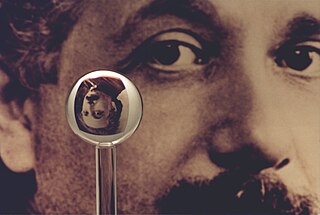
Fused quartz,fused silica or quartz glass is a glass consisting of almost pure silica (silicon dioxide, SiO2) in amorphous (non-crystalline) form. This differs from all other commercial glasses in which other ingredients are added which change the glasses' optical and physical properties, such as lowering the melt temperature. Fused quartz, therefore, has high working and melting temperatures, making it less desirable for most common applications.

Spectrophotometry is a branch of electromagnetic spectroscopy concerned with the quantitative measurement of the reflection or transmission properties of a material as a function of wavelength. Spectrophotometry uses photometers, known as spectrophotometers, that can measure the intensity of a light beam at different wavelengths. Although spectrophotometry is most commonly applied to ultraviolet, visible, and infrared radiation, modern spectrophotometers can interrogate wide swaths of the electromagnetic spectrum, including x-ray, ultraviolet, visible, infrared, and/or microwave wavelengths.
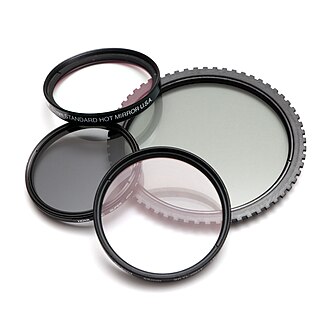
In photography and cinematography, a filter is a camera accessory consisting of an optical filter that can be inserted into the optical path. The filter can be of a square or oblong shape and mounted in a holder accessory, or, more commonly, a glass or plastic disk in a metal or plastic ring frame, which can be screwed into the front of or clipped onto the camera lens.
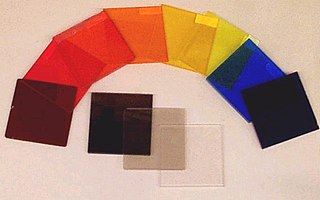
An optical filter is a device that selectively transmits light of different wavelengths, usually implemented as a glass plane or plastic device in the optical path, which are either dyed in the bulk or have interference coatings. The optical properties of filters are completely described by their frequency response, which specifies how the magnitude and phase of each frequency component of an incoming signal is modified by the filter.

In infrared photography, the photographic film or image sensor used is sensitive to infrared light. The part of the spectrum used is referred to as near-infrared to distinguish it from far-infrared, which is the domain of thermal imaging. Wavelengths used for photography range from about 700 nm to about 900 nm. Film is usually sensitive to visible light too, so an infrared-passing filter is used; this lets infrared (IR) light pass through to the camera, but blocks all or most of the visible light spectrum.

In photography, purple fringing is the term for an unfocused purple or magenta "ghost" image on a photograph. This optical aberration is generally most visible as a coloring and lightening of dark edges adjacent to bright areas of broad-spectrum illumination, such as daylight or various types of gas-discharge lamps.
A flame detector is a sensor designed to detect and respond to the presence of a flame or fire, allowing flame detection. Responses to a detected flame depend on the installation, but can include sounding an alarm, deactivating a fuel line, and activating a fire suppression system. When used in applications such as industrial furnaces, their role is to provide confirmation that the furnace is working properly; it can be used to turn off the ignition system though in many cases they take no direct action beyond notifying the operator or control system. A flame detector can often respond faster and more accurately than a smoke or heat detector due to the mechanisms it uses to detect the flame.

Full-spectrum photography is a subset of multispectral imaging, defined among photography enthusiasts as imaging with consumer cameras the full, broad spectrum of a film or camera sensor bandwidth. In practice, specialized broadband/full-spectrum film captures visible and near infrared light, commonly referred to as the "VNIR".

The FinePix IS Pro is a digital single lens reflex camera introduced by Fujifilm in 2007. It is based on a FinePix S5 Pro, which is in turn based on the Nikon D200. It has a Nikon F lens mount and can use most lenses made for 35 mm Nikon SLR cameras. It replaces the Fujifilm FinePix S3 Pro UVIR.
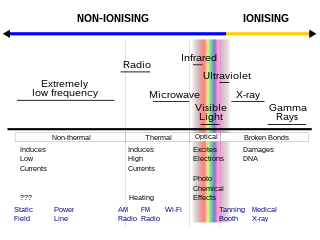
Non-ionizingradiation refers to any type of electromagnetic radiation that does not carry enough energy per quantum to ionize atoms or molecules—that is, to completely remove an electron from an atom or molecule. Instead of producing charged ions when passing through matter, non-ionizing electromagnetic radiation has sufficient energy only for excitation. Non-ionizing radiation is not a significant health risk. In contrast, ionizing radiation has a higher frequency and shorter wavelength than non-ionizing radiation, and can be a serious health hazard: exposure to it can cause burns, radiation sickness, many kinds of cancer, and genetic damage. Using ionizing radiation requires elaborate radiological protection measures, which in general are not required with non-ionizing radiation.
Microspectrophotometry is the measure of the spectra of microscopic samples using different wavelengths of electromagnetic radiation It is accomplished with microspectrophotometers, cytospectrophotometers, microfluorometers, Raman microspectrophotometers, etc. A microspectrophotometer can be configured to measure transmittance, absorbance, reflectance, light polarization, fluorescence of sample areas less than a micrometer in diameter through a modified optical microscope.
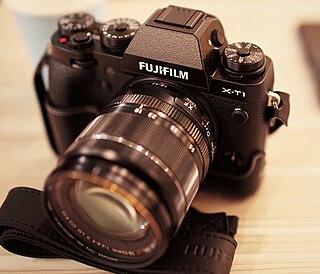
The Fujifilm X-T1 is a weather-resistant mirrorless interchangeable lens camera announced by Fujifilm on January 28, 2014. It uses the Fujifilm X-mount and is the first entry in the X-T lineage of DSLR-styled X series cameras.
